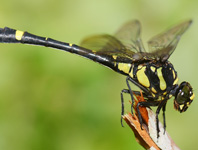Abstract
Two new species of marine nematodes, Paramphimonhystrella longispicula sp. n. in the deep-sea sediments from the Philippine Sea in the tropical Western Pacific Ocean with the water depth of 3920–5176 m and P. eurystoma sp. n. in the shelf seafloor from the East China Sea with the water depth of 55–64 m, are described. Both species possess long and slender spicules, which are present only in the congener P. barbula, a species discovered from the continental slope of New Zealand. Paramphimonhystrella longispicula sp. n. can be easily distinguished from P. barbula by the relatively broader buccal cavity, the unequally long cervical setae and a higher number of terminal setae. Paramphimonhystrella eurystoma sp. n. is unique in having a peculiar gubernaculum with two proximal capitula and a peculiar hammer-shaped cuticularized piece posterior to vulva, by which it can be distinguished from P. longispicula sp. n. and P. barbula as well as other congeners. Paramphimonhystrella longispicula sp. n. differs from P. eurystoma sp. n. also by the number of terminal setae (4 vs. 2). A dichotomous key to nine valid species of Paramphimonhystrella is provided.
References
Bussau, C. (1995) New deep-sea Nematoda (Enoplida, Thoracostomopsidae, Oncholaimidae, Enchelidiidae) from a manganese nodule area of the eastern South Pacific. Zoologica scripta, 24, 1–12.
https://doi.org/10.1111/j.1463-6409.1995.tb00470.xBussau, C. & Vopel, K. (1999) New nematode species and genera (Chromadorida, Microlaimidae) from the deep sea of the eastern tropical South Pacific (Peru Basin). Annalen des Naturhistorischen Museums in Wien. Serie B für Botanik und Zoologie, 101Bd, 405–421.
Chen, G. & Vincx, M. (1998) Nematodes from the Strait of Magellan and Beagle Channel (Chile): description of four new species of the Comesomatidae. Hydrobiologia, 379, 97–110.
https://doi.org/10.1023/A:1003494127181Chen, G. & Vincx, M. (2000) New and little known Nematodes (Monhysteroida, Nematoda) from the Strait of Magellan and the Beagle Channel (Chile). Hydrobiologia, 429, 9–23.
https://doi.org/10.1023/A:1003995005971Fonseca, G. & Bezerra T.N. (2013) Order Monhysterida Filipjev, 1929. In: Schmidt-Rhaesa, A. (Ed.), Handbook of Zoology. De Gruyter, Hamburg, pp. 435–465.
Freudenhammer, I. (1975) Neue Sphaerolaimiden (Nematoda, Monhysterida) aus der Tiefsee. “Meteor"-Forschungsergebnisse Reihe D, 21, 11–18.
Hope, W.D. & Aryuthaka, C. (2009) A partial revision of the marine nematode genus Elzalia (Monhysterida: Xyalidae) with new characters and descriptions of two new species from Khung Kraben Bay, east Thailand. Journal of Nematology, 41 (1), 64–83.
Huang, Y. & Zhang, Z.N. (2006) A new genus and three new species of free-living marine nematodes from the Yellow Sea, China. Journal of Natural History, 40, 5–16.
https://doi.org/10.1080/00222930600617781Leduc, D. (2014) Four new Paramphimonhystrella species (Nematoda: Xyalidae) from the continental slope of New Zealand. Zootaxa, 3814 (4), 478–494.
https://doi.org/10.11646/zootaxa.3814.4.2Leduc, D. (2015) One new genus and five new nematode species (Monhysterida, Xyalidae) from Tonga and Kermadec Trenches, Southwest Pacific. Zootaxa, 3964 (5), 501–525.
https://doi.org/10.11646/zootaxa.3964.5.1Lorenzen, S. (1977) Revision det Xyalidae (freilebende Nematoden) auf der Grundlage einer kritischen Analyse von 56 Arten aus Nord- und Ostsee. Veröffentlichungen des Instituts für Meeresforschung in Bremerhaven, 16, 197–261.
Miljutin, D.M., Gad, G., Miljutina, M.M., Mokievsky, V.O., Fonseca-Genevois, V. & Esteves, A.M. (2010) The state of knowledge on deep-sea nematode taxonomy: how many valid species are known down there? Marine Biodiversity, 40, 143–159.
https://doi.org/10.1007/s12526-010-0041-4Nicholas W.L. & Trueman J.W.H. (2002) The taxonomy of the family Xyalidae Chitwood, 1951 (Monysterida: Nematoda): a cladistics analysis. Nematologica, 4 (4), 453–470.
https://doi.org/10.1163/156854102760290446Platt, H.M. & Warwick, R.M. (1983) Free-living Marine Nematodes. Part I: British Enoplids. Pictorial key to world genera and notes for the identification of British species. In: Kermack, D.M. & Barnes, R.S.K. (Eds.), Synopses of the British Fauna. New Series. No. 28. Cambridge University Press, Cambridge, pp. 169–171.
Timm, R.W. (1970) A revision of the nematode order Desmoscolecida Filipjev, 1929. University of California Publications in Zoology, 93, 1–115.
Venekey, V., Gheller, P.F., Maria, T.F., Brustolin, M.C., Kandratavicius, N., Vieira, D.C., Brito, S., Souza, G.S. & Fonseca, G. (2014) The state of the art of Xyalidae (Nematoda, Monhysterida) with reference to the Brazilian records. Marine Biodiversity, 44 (3), 367–390.
https://doi.org/10.1007/s12526-014-0226-3Yu, T. & Xu, K. (2015) Two new nematodes, Pseudelzalia longiseta gen. nov. sp. nov. and Paramonohystera sinica sp. nov. (Monhysterida: Xyalidae), from sediment in the East China Sea. Journal of Natural History, 49 (9–10), 509–526.
https://doi.org/10.1080/00222933.2014.953224Yu, T. & Xu, K. (2017) Two new Oxystominid species (Nematoda: Enoplida) from an abyssal plain in the southern Philippine Sea. Journal of the Marine Biological Association of the United Kingdom. [published online]
https://doi.org/10.1017/S0025315417000042

